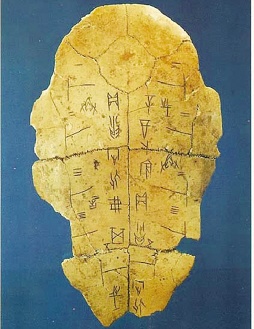Shang Dynasty
商朝
Oracle Bones
甲骨文
Oracle Bones is an ancient script carved on tortoise shells or animal bones.
甲骨文一种被雕刻在龟壳或动物骨头上的一种古代文字。
Having emerged during the Shang Dynasty (B.C.160—B.C.1000), Oracle Script is considered the oldest script in China.
甲骨文起源于商朝(公元前1600年至公元前1000年),是中国最古老的文字。
During the Shang Dynasty, the ancients reckoned the natural elements as the exertion of some mystical power.
商朝时期,古人猜测一些自然元素是某种神秘力量的施展。
When there were floods, drought, lightning and thunder, or some big events, like royal hunts, journeys and military campaigns, through divination, ancients would predict the future by “reading” the messages of nature.
当遇到洪水、干旱、闪电和雷鸣亦或是一些重大事件例如皇家狩猎、旅行、军队作战时,通过占卜,古人们可以从“解读”自然信息从而预知未来。
The divination performer first drilled holes on tortoise shell or a piece of bull scapula, then put it over fire.
占卜者首先在龟壳或者一片肩胛骨上钻洞,然后将其置于火上炙烤。
Since the shell or bone would crack irregularly under heat, the diviner could supposedly interpret these cracks as good or bad omen.
因为受热,龟壳或骨头会不规则的裂开,占卜者以此来解读这些裂纹为好的征兆或者不详之兆。

All the dates and results of the divination were written down on the shells or animal bones, which became the earliest historical document with writing symbols.
有关占卜的日期和结果都会被记录在龟壳或者动物骨头上,这也就成为了最古老文字符号的记录。
In 1899, a mandarin of the Qing Dynasty (1644—1911 A.D.) found in his doctor’s prescription a kind of medicine called dragon bone.
1899年,一位清朝(1644-1911)官吏在其医生开具的处方中发现了一味被称作龙骨的药。
When he studied it, he noticed that it actually was a tortoise shell with some odd pictures carved on it.
他着手研究并发现这其实是一种刻有古老图形的龟壳。
The mandarin then sent his men to collect dragon bones in all herbal medicine shops and had them examined by historians.
这位官员命令他的部下在所有中药铺中搜集这味中药并将其送到史学家那里检查。
Finally, over our thousand different Chinese characters were found on these bones and shells, which had been used to record divination facts.
最终,超过一千个不同的中国文字从这些曾经被用来记录占卜的龟壳和骨头上被发现。
These special dragon bones are now referred to as oracle bones.
这种特殊的龙骨就是现在人们口中的甲骨。
Now, over 100 000 pieces of oracle shells or bones have been unearthed from the ruins of the Shang Dynasty at Anyang in Henan Province, which was the latter capital of Shang Dynasty 3 000 years ago.
如今,在河南安阳,这个3000年前商朝旧都,已经有超过10000片刻有甲骨文的龟壳或者骨头从商朝的废墟中出土。
Though smaller in number, additional discoveries of oracle script in Shangcheng in the neighborhood of Zhengzhou offer valuable insights into the study of the Shang Dynasty.
此外,人们在郑州周边城市商城有了一些额外的甲骨文发现,虽然数量较小,但仍为商朝的研究提供了一些有价值的观点。











